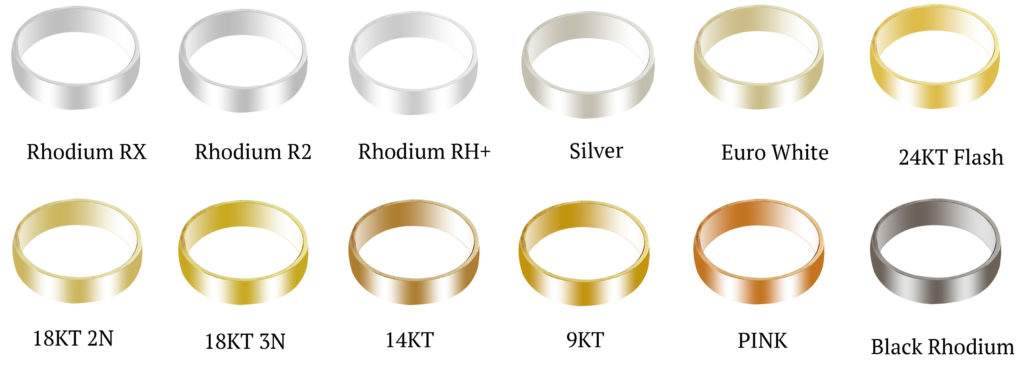Flow Studio provides Plating Jewelry services. The following is a short FAQ to help you understand better this production process. If you have any question, please feel free to contact us.

Micron refers to the thickness of the plating, determining how long the gold plating lasts before it begins to fade. There is no clear guidance on how long the plating will last, as it depends on factors such as the traffic level of the jewelry. Rings and bracelets are high-traffic pieces, necklaces are medium-traffic, and earrings are low-traffic. Higher traffic requires a thicker plating. Other factors include the wearer’s skin acidity and how they care for their jewelry, such as avoiding exposure to showers, beaches, or swimming pools.
For the lower-price market, clients often choose flash plating with a coating to extend durability while keeping costs affordable.
In the medium to high market, we recommend starting with a 2-micron thickness for rings. If the budget allows, 3 microns is ideal, as rings fade faster than other jewelry. A 3-micron thickness on a sterling silver base qualifies as Gold Vermeil, allowing you to market the ring as such.
Regarding costs, we charge clients for the ring plus the plating based on thickness. For example, if a ring costs $20 and plating is $5 per micron, plating it with 1 micron costs $25, 2 microns $30, and 3 microns $35.
We use electroplating, which involves passing an electric current through a solution containing metal ions to deposit metal onto the jewelry. For a more affordable option, we also offer flash plating, which applies a thinner metal layer quickly, followed by a ceramic coating. This ceramic layer adds extra protection against tarnishing while preserving the color of the plating.
Gold Vermeil is a term created in France for the standard level of high-end plating, which was stated to be 3 microns over Sterling Silver, thus no piece in brass can ever claim the term “Vermeil“. In the US it is standard or modified to suggest 2,5 microns is the level needed over Sterling Silver to be considered Vermeil.
We plate at any level requested by our clients, but in order for us to claim it as Vermeil, our standard is a minimum of 3 microns. Of course, if 6 microns are requested, it would be twice the gold thickness of 3 microns, which would be thicker and better for wear and longevity. However, this may increase the price, and at those costs, solid gold may be the preferred option.
It’s important to understand that all metals, including gold, are subject to tarnish once exposed to oxygen. Environmental or humidity levels also play a major role. For example, very humid climates cause metals to tarnish more quickly. Both silver and brass contain copper, which is a metal that tarnishes easily. In the case of 925 silver, the amount of copper is 7.5 percent, while brass generally contains around 77 percent copper, which is about 10 times the amount in silver, and thus tarnishes faster.
Brass is commonly used as a base material for fashion jewelry due to its cost-effectiveness, as it is much more affordable than sterling silver. However, the actual process of creating a plate in brass, silver, or gold is essentially identical.
Fashion jewelry made with brass often uses a nickel plating layer to protect the gold plating from migration or pooling due to the copper component. However, as a jewelry manufacturer, we do not use nickel.
Instead, we use palladium as a base metal, which creates a strong barrier between the base alloy and the gold plating. This helps improve the quality of the final plating and its resistance to copper migration and discoloration.
Flow uses Italian alloys in its silver that are not just pure copper but contain varied recipes designed to address issues like strength and anti-tarnish. This is more advanced and effective than the traditional use of pure copper in jewelry making.
How you care for your plated jewelry will always be the main factor in its longevity. Avoiding dishwashing, showering, or swimming, and lightly cleaning your plated jewelry with proper storage, are crucial to maintaining its appearance.
It should also be noted that some body types and compositions are more prone to acidic sweat and corrosion when it comes to metal contacting the skin. Therefore, care and light cleaning are especially important for maintaining plated jewelry.
We do not, nor will we, make any claims regarding the water resistance of gold plating. As mentioned above, we suggest avoiding activities such as dishwashing, showering, or swimming while wearing plated jewelry. Proper care, cleaning, and storage are always recommended.


